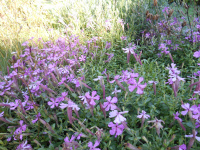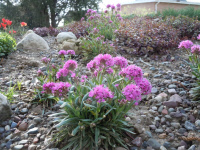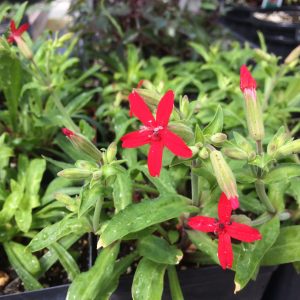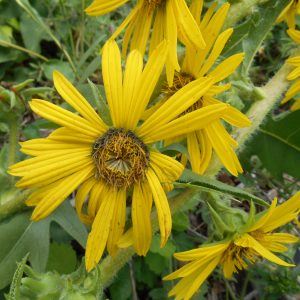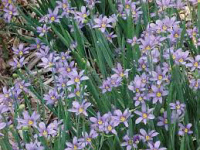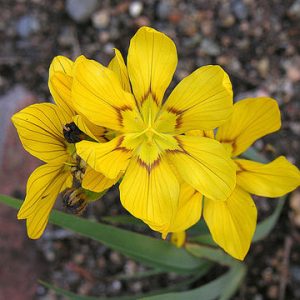Shop
Showing 681–688 of 778 results
-
Silene schafta Schaft’s catchfly, Moss Z 5-7
One of the spectacular late season blooms –clusters of five-petaled, jagged-edge, bright magenta flowers on short mounds, September to October. Perfect for front of borders or rock gardens.
OUT OF STOCK
One of the spectacular late season blooms –clusters of five-petaled, jagged-edge, bright magenta flowers on short mounds, September to October. Perfect for front of borders or rock gardens.
Size: 6” x Slowly spreading
Care: full sun in well-drained to moist well-drained soil
Native: Russia
Awards: England’s Royal Horticultural Society Award of MeritIntroduced from its native Russia in 1844. First described by and probably collected by Johann Gmelin (1709-1755) German naturalist who spent years hunting plants in Russia and authored four-volume Flora Sibirica. In Greek mythology Silene was a companion of Bacchus who was covered with foam. William Robinson, father of the mixed perennial border, described the flowers of this species as being “very neat tufts.”
-
Silene suecica syn. Lychnis alpina Arctic campion Z 4-8
Rosy racemes May- June emerge from a mound of grass-like leaves
ARCHIVED
Note: This is a plant not currently for sale. This is an archive page preserved for informational use.
Rosy racemes May- June emerge from a mound of grass-like leaves. Short-lived but reseeds.
Size: 5” x 6”
Care: Sun to part shade in moist well-drained soil
Native: Northern Asia & EuropeLychnis named by Theophrastus in the 3rd century B.C. for “lamp” (lychnos) due to using the leaves of Lychnis coronaria for lamp wicks, but some say due to the flame-colored flowers. Collected by moss expert George Don at Meikle Kilrannoch, Scotland in 1795. May 6, 1876 “The Garden” described its flowers as “forming bright rosy patches…”
-
Silene virginica Fire pink Z 4-8 Short-lived perennial, 2-3 years
Real red, hence the name Fire (not pink in color), flowers of five notched petals flaring out from a tube, blooms late spring and early summer. Named “pink” because it is botanically in the family known as Pinks, Dianthus.
ARCHIVED
Note: This is a plant not currently for sale. This is an archive page preserved for informational use.
Real red, hence the name Fire (not pink in color), flowers of five notched petals flaring out from a tube, blooms late spring and early summer. Named “pink” because it is botanically in the family known as Pinks, Dianthus.
Size: 12-18” x 9-18”
Care: part shade in moist well-drained to well-drained soil.
Native: nearly entire eastern half of No. America. Endangered species in WI.
Wildlife Value: attracts hummingbirds.1st collected by John Banister (1654-1692) Anglican minister who searched and found many plants in the Virginia colony, losing his life when he was accidentally shot along the Roanoke River while collecting plants.
-
Silphium laciniatum Compass plant Z 4-9
Tall, sunflower-like plant with big, deeply lobed, hairy leaves, that move north and south to follow mid-day sun. Two to five inch wide, sunny-yellow daisies grow at intervals along the top half of the stiff, square, sticky stem from mid-summer into fall.
OUT OF STOCK
Tall, sunflower-like plant with big, deeply lobed, hairy leaves, that move north and south to follow mid-day sun. Two to five inch wide, sunny-yellow daisies grow at intervals along the top half of the stiff, square, sticky stem from mid-summer into fall.
Size: sun to part shade in moist to well-drained soil with its deep taproot
Care: 6- 12’ x 24”
Native: East and central U.S. as far west as the Great Plains, Wisconsin native
Wildlife Value: pollinated by bumblebees, Miner bees, large leaf Cutting and solitary bees, Goldfinches feast on the seeds in fall.
Awards: Missouri Botanic Garden Plant of MeritNatives chewed the plant’s sap like chewing gum. Lakota Sioux made an infusion of the plant is used to deworm horses and humans of and to break up congestion in the lungs. Grew in Bartram’s colonial nursery by 1770’s. Grown at America’s 1st botanic garden, Elgin Botanic Garden 1811.
Named “Compass plant” for its leaves move, facing north and south.
-
Silphium perfoliatum Cup plant Z 3-9
Golden daisies waive at the sun from July to September, its cup shaped leaves hold water where butterflies drink & bathe
Golden daisies waive at the sun from July to September, its cup shaped leaves hold water where butterflies drink & bathe
Can not ship to: Connecticut and New York
Size: 7’ x 3’
Care: full sun to part shade in moist soil
Native: Central North America, native to Wisconsin.
Awards: England’s Royal Horticultural Society Award of MeritSap used by Native Americans to chew and freshen breath. Also used to cure colds, neuralgia, fever, and liver disorders. The Chippewa used to stop lung hemorrhaging, menstrual bleeding and cure chest pain. The Winnebago drank a potion from the plant to purify themselves before a buffalo hunt. For the Iroquois it cured paralysis, prevented children from seeing ghosts and illness caused by the dead. Lakota Sioux: “Children sometimes use the resin as chewing gum. An infusion of the whole plant is used to rid horses and humans of intestinal worms. An infusion of the leaves is used to loosen phlegm in the lungs. Described and classified in 1753.
-
Sisyrinchium albidum White blue-eyed grass Z 3-10
White or pale blue star-shaped flowers with yellow centers blossom over short, grass-like foliage in late spring-early summer.
ARCHIVED
Note: This is a plant not currently for sale. This is an archive page preserved for informational use.
White or pale blue star-shaped flowers with yellow centers blossom over short, grass-like foliage in late spring-early summer.
Size: 18-24” x 6-12”
Care: sun in moist well-drained soil
Native: East coast from Maine to Florida and west as far as Wisconsin
Wildlife Value: attracts bees & butterflies, Deer resistant.
Size: Menominee kept this in their house or pocket to ward off snakes.Menominee kept this in their house or pocket to ward off snakes. First published in 1832.
-
Sisyrinchium angustifolium Blue eyed grass Z 3-9
Cutest petite iris-like foliage sporting blue saucer-shaped flowers with bright yellow stamens in summer.
Cutest petite iris-like foliage sporting blue saucer-shaped flowers with bright yellow stamens in summer.
Size: 12" x 6"
Care: Sun in well-drained soil
Native: North America, Wisconsin native.In cultivation by 1732. Named by Philip Miller, gardener of the Chelsea Botanic Garden, in Gardeners’ Dictionary .
Mahuna Indians of So. California made a tea from the entire plant to expel stomach worms. -
Sisyrinchium macrocarpum Argentinian blue-eyed grass Z 5-9
In summer large yellow cups with red line encircle the center, above petite iris-like foliage
ARCHIVED
Note: This is a plant not currently for sale. This is an archive page preserved for informational use.
In summer large yellow cups with red line encircle the center, above petite iris-like foliage.
Size: 6-12” x 9-12”
Care: sun in moist well-drained soil
Native: Argentina’s central & southern cordillerasDescribed in 1881.

